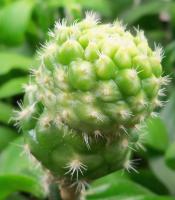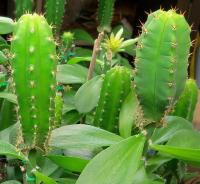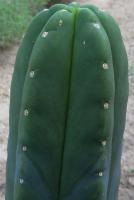-
Content count
4,095 -
Joined
-
Last visited
-
Days Won
19
Posts posted by Auxin
-
-
So much about this need testing.
Not to mention breeding.
Thing about cacti, the space that would support X number of adults can support a hundred times as many babies.
So grow a farkin hundred times as many cacti as you want, when they get crowded carefully kill 90% with freezing temps, then when they get crowded again carefully kill 90% with freezing temps. Breed the survivors and get 10,000 new seeds. Repeat.

-
 2
2
-
-
It could be argued that the definition needs to be broadened even farther to be fair to the question 'do plants have brains?' because scientists still assume that a plant brain would be connected to the plant.
Consider: plants were assaulted by bacteria, the plants guided the evolution of some of those bacteria to serve as symbiotic defenders. Then mammals and herbivory came around. The plants bacterial symbiotes evolved to influence the evolution of the grazing animals. It shaped feeding habits, immune development, seed dispersal mechanisms, and even technology. Ultimately that led to humans, "mammals" that in truth are 90% plant bacteria by cell count, mammals who not only get sick if they do not serve the plants but base much of their culture and technology around plants.
Plants have made us their brain.
-
 5
5
-
-
Depends not just on the trich species/selection but also the degree of dormancy/thirst.
If a cactus is still trying to grow it will be significantly less able to survive a freeze.
Consider also, a 25° prediction is just that. Reality can surprise. A month and a half ago my weather report predicted 25° and what I got was 8°
 A few dozen cacti were still out including 14 hardy dormant trichs, they froze solid and changed color but were still alive when they 'melted' a few days later.
A few dozen cacti were still out including 14 hardy dormant trichs, they froze solid and changed color but were still alive when they 'melted' a few days later.If possible, bring inside. If thats not possible, put a plastic shower cap or styrofoam cup on the tip to prevent damage to the most vulnerable part.
Remember eye protection when moving big honking cacti.
-
 1
1
-
-
Yeah, acronyms can suck at times
In my old home town they set up the South Lake Union Trolley public transport, so now lots of good people ride the local SLUT on the way to work.
Over on your side theres the Health Purchasing Victoria. Damn government, giving people HPV.
Sometimes you just cant win.
You can fight bad acronyms tho, I suggest founding the Acronym Standardization Society.
-
 2
2
-
-
Oh yeah, I know that one. I learned about it at 13 when I saw Vinca rosea in a book on legal highs

I never tried it tho, those alks are too hardcore- theyre real chemo drugs with all the associated implications of hair loss and explosive vomiting, loss of immune function, etc.
If I were ever desperate enough to go in for chemo I'd let the doctors administer that stuff but I'd look into preparatory prolonged fasting. Theres some interesting research being done there. Apparently going on a 0 calorie starvation fast for 3 days before the chemo (and obviously fasting while sick on chemo) shuts down the healthy immune cells as much as possible, protecting them from the chemo, but the cancer still acts like a drunken college student and so gets killed by the chemo. On top of that, research shows that prolonged fasting effectively 'de-ages' the immune system both in the efficiency of individual immune cells and restoring proper ratios between immune cell types (which go off balance with age). Cool stuff.
-
Theyre actually about a year old, only recently (few months) grafted. I had carefully hardened the babies off and grew them under the full sun this year so the monsters wouldnt be limp-wristed and rot prone. It was only as fall approached that I grafted some of the non-monsters onto pereskiopsis and put them under lights, thats why they're wedge grafted. So all relevant visible growth was done while grafted and under lights, but it was done on seedlings that had grown hard under summer sun for some time.
-
 1
1
-
-
Yeah, it may just be eager to grow up, or perhaps more willing to give proper growth under artificial light. It'll be interesting to compare them in september after they've both spent six months under full sun.
If the right one is simply mimicking a more mature phenotype it begs the question, is that a behavior that can be artificially induced.
-
For bridgesii (and other trichs) my method is simple: in summer treat them like potted tomatoes, in winter treat them like dried flowers (in my climate winter growth means massive etiolation). In heat and strong sun these type of cacti like water and ferts.
This year, as an experiment, I planted several scopulicola in water soaked pine duff. Supposedly a mix that would make a cactus just explode on the spot and would have me up on charges as a psychotic cactus murderer... I've never seen scops grow so fast.
Ignore any 'traditional' cactus growing advice unless your growing traditional cacti- like mammillarias or astrophytums.
-
 2
2
-
-
-
Really? So does this mean when a plant pollinates itself (like an L. williamsii) they aren't clones but genetically different seedlings?
When a plant pollinates itself, correct, each seed is a genetically distinct individual.
Seed form clones happen as well tho, its called apomixis. That happens with impossible crosses that actually produces seeds (Harissia jusbertii is the classic cactus example, it cant pollinate itself but if you pollinate it with a trich each seed will be a exact clone of the mother). It also happens with crosses that are viable! In literature on Opuntia and Hylocereus breeding you can see where they have to sort out whats a true cross and whats an apomict in any given group of 'siblings' from a single cross.
To date I havent seen any evidence establishing just how much of a role apomixis plays in the cement tek pollinations.
-
 5
5
-
-
-
 I think I can make out the constellation Orion
I think I can make out the constellation Orion
-
 1
1
-
-
yup, thats an impale with a few root buds.
-
So I have a bunch of Psycho0 X TPM and TPM X N1 plants growing. The TPM X N1's all look the same and, not surprisingly, very similar to the Psycho0 X TPM's which also all look pretty much the same... with one glaring exception.
On the left is a normal Psycho0 X TPM, on the right is the odd one, behind it on shorter stock are some TPM X N1's.
The odd Psycho0 X TPM is fatter, darker, has fewer ribs, fewer spines, fatter spines, darker spines, wider V notches.
It looks like what I'd expect a psycho0 pup growing on Pereskiopsis to look like.
Did I get an apomict seed or is this just some wild outlier or contaminant seed?
-
 4
4
-
-
-
I suddenly understand why your so specific in wanting spineless T. scopulicola

-
 3
3
-
-
Well I'm glad you specified you meant animal husbandry, my state recently outlawed the other kind of dairy sexing.
-
Dry and desiccated are not the same.
Not dry means it'll rot in a day if kept in a baggie.
Dry means it's water is reduced to something on the order of 14% and may stay viable for a week in the refrigerator.
Desiccated means its water is reduced so much it'll last a year or more if stored in a jar with some desiccant in the freezer.
Theres a paper relating to it [Here]
Indicating desiccant can be found in arts and crafts stores, its used in drying flowers.
-
 4
4
-
-
I propose that we all abandon written language and begin communicating in brief grunts

-
 4
4
-
-
Fuck sake pimento, I hope your replacing the labels with better ones or planting in a very well defined grid and making a map.
It'd be a shame to have no idents on those in 5 years
-
 2
2
-
-
the applicator wands are those things that girls use for eye make up ... :DOh now you specify, you could have saved my mind that brief attempt at pollinating a cactus with a tampon

-
 2
2
-
-
paintbrushes / applicator wands for pollinating
Trouble with paintbrushes for pollinating is when your number of cacti exceeds your number of paintbrushes.
I solved that issue one day when I pulled a fluff ball of hair off my dog, taped it to a nail, and trimmed the end even.
You can make lots of paintbrushes from a roll of tape and a shedding dog.
-
 2
2
-
-
First post says it was coined as Lumberjackius but was promptly changed to Lumberjackus.
The latter really does sound better, IMO.
-
 3
3
-
-
Why has everyone shortened it to Lumberjack?
'Lumberjackus' is an awesome name, it sounds like it was named after a male stripper.
-
 3
3
-






Circumcision causes autism and ADHD?
in Chill Space
Posted
Unusual finding.
[Link]
I find it interesting, though, that they seem to flatly ignore the possibility that the correlation may exist by a biological mechanism rather than psychological. Little fun flap producing hormones or neurological impulses that effect the brain, etc.